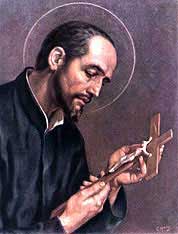Saint Anthony Mary Zaccaria Catholic Saint
CATHOLIC SAINTS 28-12-2023, 19:38

Saint Anthony Mary Zaccaria
Catholic Saint
st.Anthony Mary Zaccaria-Cofounder of the Barnabites, the regular Order of St. Paul
Feast Day : July 5
Also known as: Antonio Maria Zaccaria
Anthony Mary was born in 1502 in Cremona, in Lombardy (Italy), to wealthy patrician parents. His father Lazzaro died when the boy was two, widowing his mother, Antonia Pescaroli, at 18. She devoted the rest of her life to her son and his education, sending him to school in Cremona and Padua. She also taught Anthony Mary compassion for the suffering and destitute. In 1520, Anthony Mary began studying medicine at Padua and received his doctor of medicine degree at 22. He returned to Cremona to practice, but instead began studying theology and ministering to the poor and sick. Still a layman, Anthony Mary nevertheless began teaching the catechism to both children and adults from the small church of St. Vitalis next to his mother’s home. He served in prisons and hospitals, especially during the plague of 1528, and the citizens of Cremona began calling him an apostle. Anthony Mary received ordination in January 1529 and preached his first sermon from St. Vitalis, surrounded by only family and friends.
Legend holds that angels were seen at the altar. Anthony Mary’s work was so successful that he wanted to expand his ministry. But first the Dominican, Fra Battista, a friend of Girolamo Savonarola, named him chaplain to the wealthy Ludovica Torelli, countess of Guastalla. In 1531 the countess, Fra Battista and Anthony Mary traveled to Milan, where they joined the Confraternity of Eternal Wisdom. Along with two Milanese priests he met at the confraternity Giacomo Morigia and Bartolomeo Ferrari Anthony Mary organized a congregation of secular clergy to combat the effects of years of famine, war and plague that had scourged Milan and all of northern Italy. Their idea was to establish three religious families within the community priests, sisters and lay people and Pope Clement VII (r. 1523–34) agreed, approving the Sons of St. Paul in 1533. In 1535, the congregation became the Clerics Regular of St. Paul with the approval of Pope Paul III (r. 1534–49) and under the superiorship of Anthony Mary. In 1536, Anthony Mary named Father Morigia as superior and went to Vicenza to reform the clergy and bring two communities of sisters to stricter observance of their rules. The countess, meanwhile, had been gathering young women in her home in Milan who yearned for a spiritual life. Pope Paul III recognized these women, known as the Angelicals of St. Paul, under the Rule of Augustine in 1535, formalizing the second part of Anthony Mary’s vision. The third part, the lay followers, was the Marrieds of St. Paul. All three families shared the same zealous mission for reform and preaching, encouraging daily Communion, penitence and service to the sick and poor.
They established the ringing of church bells at 3:00 P.M. every Friday to commemorate the death of the Lord on Good Friday, and the Forty Hours Prayers: exposition of the Sacrament by turns in the various city churches. The zeal of Anthony Mary’s congregation did not inspire all Milanese citizens, however. Anthony Mary and his followers were accused of Pelagianism and the heresies of the Beguines and the Poor Men of Lyons. Their association with Fra Battista made them suspect as well. Church and civil authorities tried the Sons of St. Paul on October 5, 1534; the trial ended in dismissal. Then both the Sons of St. Paul and the Angelicals were tried from June through August 1537; that trial ended in full acquittal. The trials only stiffened Anthony Mary’s resolve, leading to more reform missions and the acceptance of the rule of poverty for the congregation. Anthony Mary had already relinquished his considerable inheritance many years before. By 1539, Anthony Mary sought a church to house his growing congregation. He was offered the Church of St. Barnabas in Milan, which eventually gave the congregation their more common name: the Barnabites. Anthony Mary did not live to see his followers in the church, however.
While back in Guastalla in May 1539 he fell ill with fever. Believing his end was near he asked to be taken home to his mother in Cremona, where he died peacefully on July 5 at age 37. He was supposedly granted a vision of St. Paul just before death. After the funeral in Cremona, Anthony Mary’s body was returned to Milan and buried at St. Paul’s Convent of the Angelics. The faithful immediately venerated him as Blessed, but he missed automatic canonization after 100 years of veneration by only five years when Pope Urban VIII (r. 1623–44) issued new rules for sainthood in 1634. His body reportedly was still incorrupt 27 years after death. Anthony Mary’s cause was reintroduced in 1802, with three miracles approved for full canonization in 1897.

The Genealogy of Jesus Christ Matthew 1:16 HD-Wallpapers and Jacob the father of Joseph the husband of Mary,...
Learn more
Christmas Wishes Christmas is a box of tree ornaments HD wallpapers Download Christmas is a box of tree...
Learn more.jpg)
John 7:1-53 THE HOLY BIBLE The Gospel According to John Chapter 7:1-53 John 7:1 After this, Jesus moved...
Learn more


